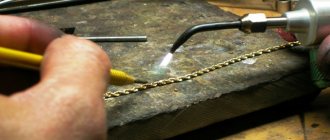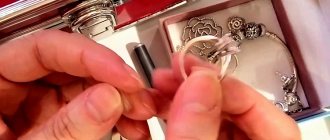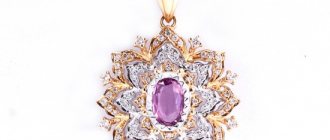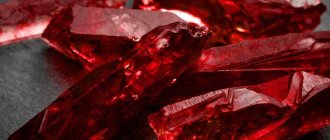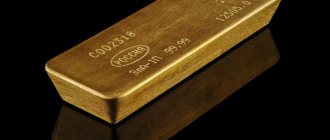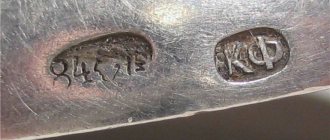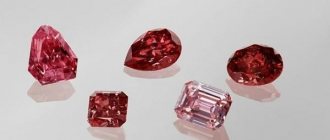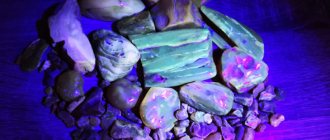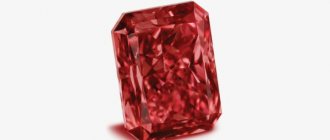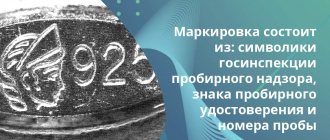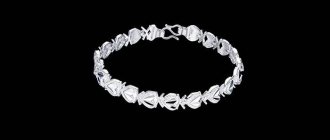Gemological examination: what is it and when is it carried out?
Gemological examination refers to a comprehensive examination of precious stones and jewelry by a certified specialist for authenticity, quality, type and place of origin.
The peculiarity of the study is that it combines the features of commodity science, soil science and cultural expertise. Therefore, extensive knowledge is required to perform the analysis. The study is carried out using special diagnostic equipment. Accuracy depends on the professionalism of the expert and the serviceability of the equipment.
During gemological analysis, a specialist determines:
- Size, weight of decoration.
- Market value of the product.
- Authenticity.
- Type of mineral (natural, synthetic).
- Processing conditions.
- Qualification of the master who performed the processing.
- Whether the item being analyzed was part of a piece of jewelry.
The duration of the procedure varies from 3 to 30 days . At a high level of complexity of the work and the specialist’s workload, the analysis time may be increased.
The need for expert assessment
When making purchase and sale transactions in relation to expensive jewelry and individual precious stones, an accompanying examination is required. This is of interest, first of all, to the buyer, who must know the real consumer properties of his possible purchase. Only a gemological conclusion will help determine the objective quality characteristics of the stone and eliminate possible misrepresentation on the part of the seller.
The largest companies in the jewelry market, which have an impeccable reputation and value it, when selling jewelry, provide the product with an expert opinion or certificate from one or another independent gemological laboratory. For example, the Moscow Jewelry Factory accompanied its Royal collection with certificates of conformity from the Moscow Gemological Center (MGC).
Checking any report for authenticity is an important element of supporting the document flow of gemological laboratories. If any modifications were made to the product, resulting in changes in weight, dimensions, or number of inserts, then the report is considered not to correspond to this product. That is why the independent company MGC provides online verification of its reports so that the buyer can be sure that he is purchasing exactly the item for which the conclusion was issued.
What affects the price?
Russian companies specializing in gemological examinations set different prices for the work. The cost depends on the following factors:
- Difficulty level.
- Depth of research.
- Equipment used.
- Mass of stone (jewelry).
- Complexity of work.
- Urgency.
- Methods used.
- Availability of additional services.
- Location of analysis.
- Number of items submitted for research.
- Type of expert opinion.
The greater the mass of the stone and the number of items, the higher the price for the analysis of one item. They also increase the price of additional services (courier delivery of documentation, individual packaging of jewelry for sale), and urgency. On-site examination is expensive.
Expertise
Goals and objectives of diamond examinationOperating principles of gemological laboratories
Certificates and expert opinions
Diamond examination procedure
Goals and objectives of diamond examination
In the diamond market, there is a need for quality assurance, just like for any other product. However, diamonds are a specific product, and one of the most significant properties for the consumer is its authenticity, i.e. the consumer must be confident that he is being offered a real diamond. Certification, understood as confirmation of the compliance of a product (in our case, a diamond) with any standard, is not really needed in the market in this form, because There are no international standards for diamonds and their classification. Rather, what is needed is not a certificate, but confirmation of authenticity, an assessment of quality and consumer properties made by independent experts.
Documents issued by independent gemological laboratories are gemological expert opinions or reports. And these documents are called differently: report, quality report, laboratory report, quality document, dossier, passport or certificate. Some of these names are registered trademarks, i.e. property of certain laboratories. In trade, all these documents are often called “certificates”, in particular because this word is known to the consumer, and also because to a large extent the content of the reports is information about the authenticity and quality of the diamond as a product. However, it should be borne in mind that in Russia the concepts of “certificate” and “expert opinion” have different meanings, and read more about this below. A report from a gemological laboratory, an independent third party, certifying the authenticity and quality of a diamond plays an important role in building consumer confidence, as well as an important role in determining the diamond's price.
Therefore, the presence of a report on a diamond at the retail stage is a “competitive advantage” of a diamond compared to a diamond without a report. A report, or report on a diamond, is a special document that certifies the authenticity of the stone, registering the weight, color, clarity, shape and degree of cut perfection, as well as the distinctive features of the diamond, determined during special gemological tests. The report guarantees the buyer the authenticity of the purchased diamond, as well as the compliance of its characteristics, on the basis of which the value is determined. The data presented in the report allows the stone to be identified and, thus, provides the owner with additional benefits in case of loss, theft, repair and alteration of jewelry, and facilitates the sale, storage, appraisal, insurance and other operations. Typically, the report does not indicate the monetary value of the diamond. If it is necessary to determine the cost and document it, another document is created - the Valuation Report. Laboratory services for analyzing a diamond and issuing a report are the actions of a third party, independent of the seller and buyer, manufacturers or trade. Independence ensures the objectivity of the laboratory's work.
Operating principles of gemological laboratories
Already several decades ago, the need to regulate the activities of various laboratories was recognized, and in order to create uniform standards and methods at the Amsterdam Congress in 1975, the World Federation of Diamond Bourses (WFDB) and the International Diamond Manufacturers Association (IDMA) developed a number of recommendations for laboratories involved in the expert evaluation of diamonds : • legal and financial independence of the laboratory from production and trade organizations; • scientific approach; • use of one of the well-known assessment systems; • recognition in your country.
Each laboratory develops its own policy regarding whether or not to issue reports on synthetic, treated and composite stones. There are two main options: if the laboratory determines the stone is artificial, refined or composite, it is either returned to the client without issuing a report, or a report is issued that provides complete information about the nature of the stone. In 2004, the World Federation of Diamond Bourses (WFDB) issued a call to all laboratories regarding the handling of synthetic and HTHP diamonds. It is proposed to issue report forms of a different color for synthetic and refined diamonds, and to make more efforts to ensure that information about synthetic origin or refinement is located in the most visible place.
Certificates and expert opinions
According to the Law “On Technical Regulation”, certification of precious stones in Russia is voluntary. Organizations that certify diamonds must work in one of the certification systems registered with Gosstandart. Their certificate is a confirmation of the diamond’s compliance with the current specifications in Russia. Other expert services existing in our country, without having the right to issue a certificate in a legal sense, based on the results of diagnostics and evaluation of diamonds, issue documents similar in status to foreign reports, i.e. expert opinions. The fundamental differences in the status and content of certificates and expert opinions are shown in the table:
Differences between certificates and expert opinions
| Expert opinion (report) | ||
| Legal status | Mandatory for the sale of loose diamonds to individuals | A diamond with an expert opinion can be sold to a person who has a registration certificate, a jeweler or a dealer company |
| An object | Unset Diamond | Diamonds, other stones, jewelry |
| Potential Buyers | Individuals | Jewelers and dealers for unset stones, individuals - for set ones |
| Key Statement | The diamond complies with the standard, specifications | The diamond is genuine, has certain characteristics and quality |
| Rating system | TU, future enterprise standards | International and Russian |
Both certificates and gemological expert opinions will not contain information about the cost of the stone.
Such information may contain documents of a different type - assessment reports issued by organizations and individual entrepreneurs who have a license for assessment activities. Diamond examination procedure
Acceptance of stones for examination. Diamonds to be graded are recorded and weighed to the nearest 0.0005 ct. An acceptance certificate is drawn up - the transfer of valuables with a record of the weight of the diamond and its other characteristics, which are entered and stored in the laboratory database. The diamond is assigned a number to identify the stone at the end of the examination process, and the owner is issued an invoice for the laboratory's services. To ensure anonymity, from this moment until the end of the examination, the client’s identity is not disclosed.
Diagnostics. To establish the authenticity of a diamond, conventional identification is performed, such as using a thermal conductivity tester. Next, a microscope is used to check whether the stone is artificial moissanite. If there is any doubt about the natural origin of a diamond or its color, the stone is sent for spectrophotometric and spectrofluorimetric analysis.
Expert evaluation of a diamond involves providing information on clarity, symmetry and quality of finishing, as well as plotting clarity characteristics on special diagrams for a given type of cut. At this stage, two experts work independently with the stone, each of whom stores the received data on a computer; These data are verified and then the final result is obtained.
The cut assessment consists of an assessment of proportions and an assessment of finishing. Any symmetry deviations that affect the appearance of the stone are determined. A proportionoscope, micrometer, and HRD microscope are used. Proportions are assessed only for round diamonds; for other cuts, proportions are measured, but a final assessment is not made, since there are no generally accepted standards for assessing fancy cuts. The last step in quality control of a cut is its evaluation using a 10x triplet magnifying glass.
Color assessment. By color, diamonds can be classified either as cape series, characterized by a yellowish tint, or as fancy-colored diamonds. A cape diamond is visually compared to a laboratory set of reference stones under standard lighting conditions. Determining the color characteristics involves two experts who independently compare the color of the stone with standard diamonds. This data is studied by a third specialist who produces the final result. Fancy color diamonds are assessed by visual comparison using color tables.
Fluorescence. The fluorescence (also known as luminescence) of a diamond is assessed in a special installation with a long-wave UV light source, and then compared with the fluorescence of standard stones.
Cleanliness assessment. The diamond is examined under magnification: a tenfold magnifying glass and a microscope. In some cases, the dimensions of a diamond's internal characteristics are determined using a grid applied to the microscope eyepiece. When assessing purity, the number and size of inclusions, their brightness, location, and the number of faces through which they can be observed are taken into account. The purity group is selected according to a table that takes into account all these factors, the degree of transparency, structural and surface defects. The diamond is then examined using a 10x triplet loupe to ensure the clarity group meets international standards. Purity assessment is performed by at least two assessors independently of each other.
At the end of the described procedures, an expert report is drawn up containing the following information: the dimensions of the diamond, its weight, proportions, quality of polishing, color and clarity characteristics, as well as a chart for this type of cut as an illustration of the clarity of the diamond. The stone is returned to the owner along with an expert report in the packaging in which it was delivered to the laboratory.
Types of research
According to the object of study, gemological examination can be:
- Checking precious goods and products.
- Studying antiques.
- Research of precious stones.
- Study of collection geological materials.
Depending on the location of the analysis, it happens:
- In the office laboratory . A client brings a piece of jewelry to the company for inspection.
- Traveling . The specialist travels to the address specified by the customer with all the equipment necessary for the study. This saves the client from time spent traveling to the office, but makes the service more expensive.
According to the methods used, the gemological expert procedure is:
- Instrumental . The origin of the mineral, authenticity, characteristics, and approximate market value are determined.
- X-ray . The mineral type, structural variety, and defects are identified. A quantitative and qualitative assessment of the composition is given.
Problems solved by gemological examination:
- Diagnostics of gemological objects: establishment of type, properties and characteristics;
- Classification of gemological objects by name and code;
- Etiology and ownership of gemological objects, as well as their identification;
- Establishing the average market value of the hemological object under study, based on its variety, weight, type, naturalness, color, etc.;
- Determination of the true customs value of the item;
- Establishing the authenticity of identification marks, stamps, samples, customs seals of precious materials;
- Identification of the operational and environmental safety of gemological goods;
- Determining the possible dual use of a gemological product;
- Establishment of standards for the yield of the finished product from customer-supplied raw materials and its identification;
- Diagnostics of jewelry and household products of mass production: jewelry, antiques, museum valuables, etc.;
- The relationship between the ownership of gemological goods and objects of historical, artistic and archaeological folk heritage of foreign countries and Russia.
Cost of gemological research
Approximate cost of gemological examination in Russian companies:
- Studying jewelry without a stone - from 4,000 rubles .
- Analysis of products with diamonds, alexandrites, sapphires, rubies, emeralds - from 5,000 rubles .
- Examination of jewelry with non-precious stones - from 1200 rubles .
- The estimated market value of the jewelry is from 5,000 rubles .
Issuance of the analysis result is subject to an additional charge. A written report with a photograph is estimated at 800 to 1,500 rubles . An oral consultation costs about 700-1000 rubles .
Cost of preliminary examination
Primary (diagnostic)
oral 700 R
- Determining the mineral type of stone or other insert material
- Determining insert weight in carats for loose inserts
- Determining the nature of the origin of the insert (stone) - natural, synthetic or artificial
- Detection of the presence/absence of improvement (visual research methods)
700 R
Standard
from 1,700 R
- Determining the mineral type of stone or other insert material
- Determination of the estimated mass of the insert fixed into the jewelry item , in carats
- Determining the nature of the origin of the insert (stone) - natural, synthetic or artificial
- Identification of the presence/absence of refining, its type and degree of impact on the cut stone (including spectral research methods)
- Determination of quality characteristics according to ISO TR (GIA)
- Based on the results of the examination, a “PRELIMINARY STUDY REPORT” is issued - it is not a certificate of conformity
from 1,700 R
Extended
from 5000 R
- Determining the mineral type of stone or other insert material
- Determination of the estimated weight of the insert fixed into the jewelry, in carats
- Determining the nature of the origin of the insert (stone) - natural, synthetic or artificial
- Identification of the presence/absence of refining, its type and degree of impact on the cut stone (including spectral research methods)
- Determination of quality characteristics according to the standards of STO MHz, ISO TR (GIA) and in accordance with GOST
- Determining the area of origin of natural stones, such as emerald, ruby, sapphire, etc. (only for loose stones)
- Determination of additional individual characteristics of the stone through a comprehensive spectral study
from 5,000 R
Tariffs and prices
